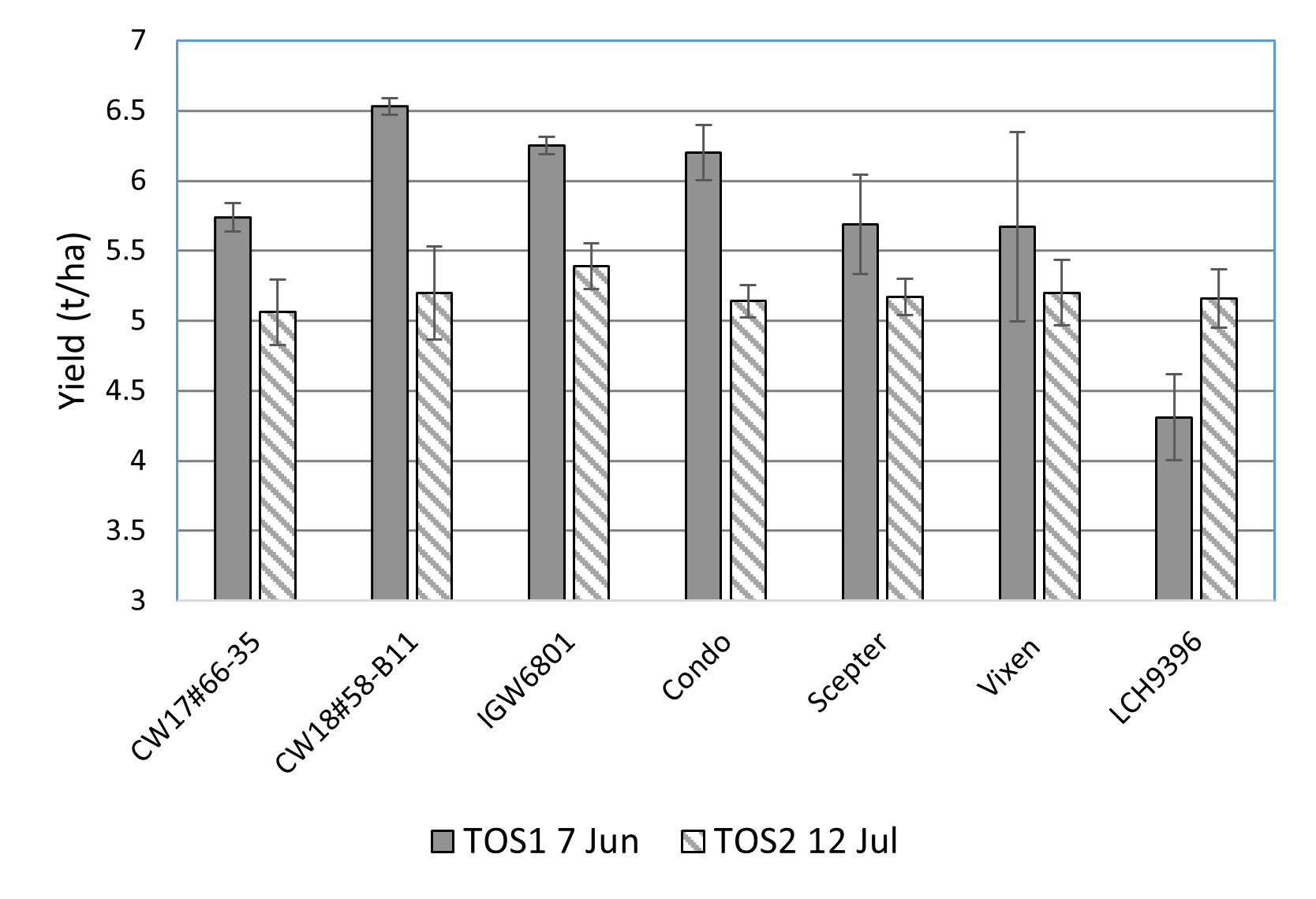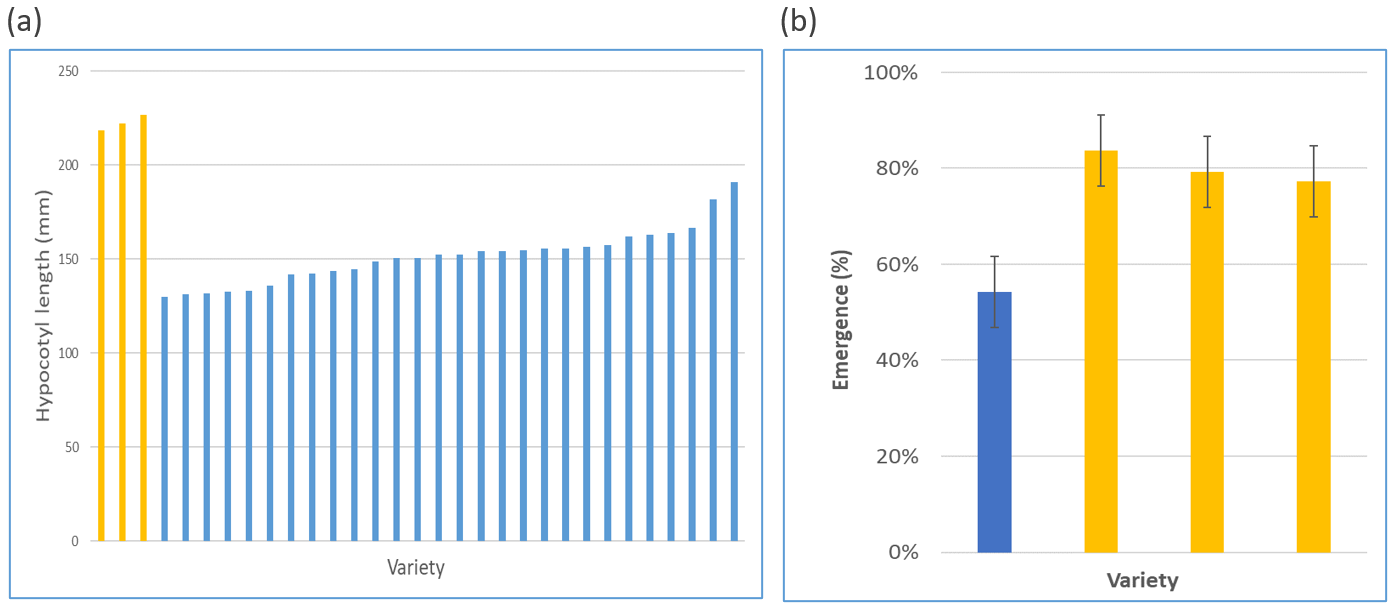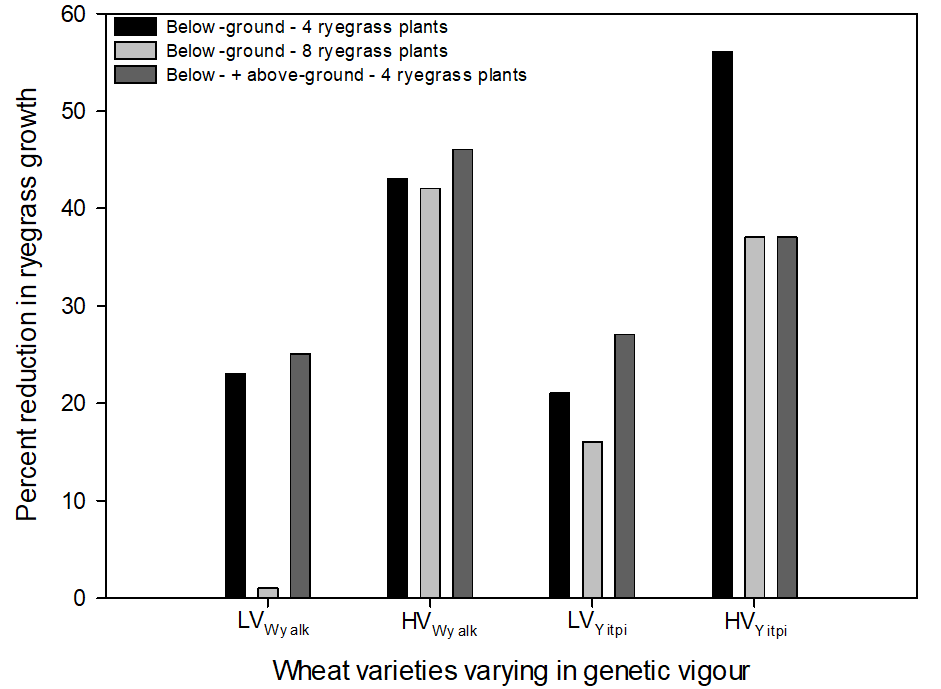Novel seed traits – an update on recent R&D
Take home messages
- The long-term climate trend is for increasing summer rain and later autumn sowing breaks throughout the Australian wheatbelt. Long coleoptiles and hypocotyls will permit deeper sowing of winter crops into summer-stored subsoil moisture allowing timely, earlier germination, and crop growth to occur under conditions optimal for maximising water productivity.
- Breeding improved establishment, which together with greater early vigour, should increase weed competitiveness to aid in weed and herbicide management, and increase nutrient uptake/nutrient-use efficiency. Greater biomass with higher vigour should also facilitate the breeding of crop varieties for later sowing in frost-prone regions or where dry sowing and double-knock weed control strategies are commonplace.
- Methods developed in assessment of seedling vigour in wheat are being translated into canola and other crops to hasten the identification of new genetics and speed the delivery of improved crop varieties for changing climates.
Aims
To identify and validate traits contributing to timely and reliable seedling emergence and greater seedling root and shoot growth.
Translate learnings in genetic improvement of seedling establishment and growth in wheat to other crops in order speed delivery of new crop varieties with improved adaptation to changing climates.
Background
The seed contains all the necessary nutrients, sugars, and primordia for the first 3–4 weeks of seedling growth. All components are necessary in optimising coleoptile (or hypocotyl) and shoot and root growth, highlighting that seed quality sets the potential for establishment and early growth of the crop. Environmental challenges including competition by weeds, reduced soil moisture and high temperature, chemical and physical soil constraints, and sowing depth can act to limit this potential to reduce plant numbers and, where extreme, result in crop failure. Genetic variation is available to meet these challenges, and tools are being developed to assist breeders in the release of new crop varieties that, together with improved systems knowledge, will improve early crop growth, particularly with increasing climate variability.
This update paper highlights current research in genetic understanding to improve seedling growth and particularly increased emergence and establishment, and early leaf and root development. Presented examples are focused on wheat and include translation of learnings from wheat to adoption in other crops.
Improved wheat establishment
Timely and successful plant establishment is critical to crop productivity in rainfed farming systems. Early emergence combined with optimal phenology increases yield potential due to a longer duration for root, tiller and crop growth while ensuring conditions are suitable for growth and flowering, and during grain-filling. Well-established crops also provide ground cover to protect soils, reduce water loss through soil evaporation, and increase crop competition with weeds.
Changing weather patterns are associated with proportionally greater summer rainfall and increasingly later sowing breaks (Flohr et al. 2021; Scanlon and Doncon 2020). There is increasing interest in deep sowing into subsoil moisture (at depths up to and exceeding 10cm) to better utilise sowing opportunities after summer and early autumn rainfall and ensure earlier germination and establishment (Rich et al. 2021; Flohr et al. 2022). However, the shorter coleoptiles and hypocotyls of many current crop varieties limit sowing depths to less than 10cm and commonly as shallow as 3–5cm. High-throughput phenotyping methods have been developed and fine-tuned to screen global germplasm and identify genetic sources for use in breeding. At the same time, recognition of the critical importance of characteristics in the seed in improving seedling establishment and early growth has focused efforts in assessment of global germplasm in breeding greater shoot and root vigour.
The long coleoptile Mace experimental line (‘Mace18’), containing a new Rht18 dwarfing gene, established well at sowing depths of 120–140mm (up to 80% of 40mm control depth) across southern, eastern and western Australia in 2020, 2021 and 2022 (for example, see Figure 1). Establishment with deep sowing of the experimental line Mace18 was as good as the older tall, long coleoptile wheat variety Halberd. Coleoptile lengths were measured at lengths of 120mm+. By contrast, the shorter coleoptile of commercially available Mace reduced establishment with deep sowing (30–40%). The new AGT variety Calibre also emerged well with deep sowing compared to Mace and Scepter (Figure 1). Grain yields were significantly (P<0.01) greater for deep-sown Mace18 in 2020 and 2021, and we are awaiting yield data in 2022 at up to 10 sites throughout Australia. Crop modelling analysis of previous research and grower data suggests an 18-20% increase in wheat productivity with improved establishment when deep-sowing particularly when targeting early-to mid-April sowing dates (Zhao et al. 2022).
Figure 1. Mean number of plants/m² (at 200ᵒCd) at four WA sites in 2021 for shallow-sown (4cm) and deep-sown (12cm) Mace Rht2 and Rht18 NILs ■, tall, long coleoptile variety Halberd ■, and commercial Rht2 dwarfing gene varieties Scepter and Calibre. Lsds were 8, 16, 6 and 6 plants per m² for Latham, Holt Rock, Beacon and Hines Hill, respectively.
Improved canola establishment
Poor establishment of canola (Brassica napus L.) is a widespread problem in Australia and globally with an average 50% or less of germinable seeds successfully establishing (McMaster et al. 2019). New laboratory-based, screening methods were adapted from wheat for high-throughput assessment of hypocotyl length. Figure 2(a) shows significantly (p<0.05) longer hypocotyls in three overseas canola varieties compared with representative Australian varieties. As in wheat, validation of laboratory conditions was needed to confirm performance with deep sowing in the field. Figure 2(b) summarises emergence data for Boorowa (one of four sites) in 2021 for the best Australian and overseas canola varieties under laboratory conditions. At the 50mm sowing depth, the three longest hypocotyl overseas varieties had significantly (p<0.05) higher emergence rates than the best Australian variety. As in wheat, rapid laboratory-based screening methods appear effective in identifying varieties with improved establishment potential. Experimental data from 2022 confirm these field-based results are repeatable.
Similarly, preliminary results indicate genetic variation for greater mesocotyl length among oat gene breeding germplasm (Tanu et al. 2023). As for wheat and canola, the potential exists in breeding oats with improved establishment when deep-sowing. As oats are the only winter cereal possessing a mesocotyl, sowing deeper than wheat maybe possible but requires validation.
Figure 2. (a) Laboratory-based hypocotyl length for three selected overseas canola accessions (yellow) and 28 Australian varieties (blue) (Lsd = 25mm); and (b) percentage seedling emergence with deep-sowing (5cm) in the field for the best overseas long hypocotyl accessions (yellow) and best Australian canola variety (blue).
The laboratory-based methods and physiological understanding developed over three decades in wheat are being translated and modified accordingly to fast-track breeding in other crops. It is predicted that crop varieties with potential for deep-sowing will be available across most crops in the next decade to aid in de-risking poor establishment with predicted changes in the amount and timing of Australian rainfall and increasing soil temperatures.
High early vigour for improving performance with late sowing
Reductions in April–May rainfall have been mirrored by a shift in increasing rainfall later in the season (Cai et al. 2012). Growers are therefore faced with the decision to sow dry and risk poor germination. Additionally, double-knock herbicide strategies, soil amelioration, double-cropping, and pest and disease control all take considerable time to complete at the beginning of the season. The option to sow later in the season would provide more time to remediate soils and implement necessary weed control strategies. However, later sowing is tightly linked to growth under cooler temperatures, in turn reducing crop biomass and grain number to reduce yield.
New high early vigour genetics bred over 30 years at CSIRO has shown promise in rapid growth after emergence, even when sown later in the season. Figure 3 summarises grain yields at Wagga Wagga in 2021 for experimental high vigour breeding lines (CW17#66-35, CW18#58-B11 and LCH9396) and commercial varieties at two sowing dates. Later sowing reduced time to flowering from an average 133 to 107 days (p<0.001), and reduced grain yields (yet still exceeded 5t/ha). The experimental high vigour lines (‘CW_’) achieved the same higher yields as the more vigorous commercial varieties Condo and Vixen despite not being selected for grain yield. Of the different plant traits measured, the strongest association with grain yield in the later sowing was with increased plant height, greater early biomass and ground cover (Green et al. 2023). These high vigour genetics have been delivered and are being used in commercial breeding programs.

Figure 3. Grain yields of selected wheat lines sown on two sowing dates (TOS) at Wagga Wagga in 2021. Closed horizontal bars represent standard errors. Lsd (Genotype) = 0.75t/ha, Lsd (TOS) = 0.11t/ha, Lsd (Genotype × TOS) = 1.07t/ha.
Greater seedling vigour to increase crop competitiveness
Herbicide resistance, together with the high cost of pre-emergent herbicides, represent a substantial cost to Australian growers. Yield losses of up to 25% are sometimes reported where weed control is inadequate, while carryover of weed seed can present a major cost in subsequent crops while increasing risk with herbicide resistance with already limited chemical control options. Older crop varieties were very effective in competing with weeds. They were taller and produced greater leaf area early in the season to compete with weeds for light, while there was indication of their ability to also compete effectively below-ground (Hendriks et al. 2022).
Figure 4 summarises the significant (p<0.05) reduction in ryegrass biomass in high early vigour (HV) selected Wyalkatchem and Yitpi derivatives carefully assessed in seedling pouches. The influence on wheat vigour in reducing ryegrass growth was consistent at moderate (635 plants/m2) and high (1270 plants/m2) ryegrass densities, and whether growth of the ryegrass was competing above- or below-ground with the wheat. The suppression of ryegrass growth by the high vigour lines was more than two-fold the suppression of ryegrass growth by the low vigour parents. The results in this controlled laboratory assessment are consistent with field observations currently being analysed (P. Hendriks unpublished data).
Conclusions
The seed contains all the necessary machinery to assure the first 3–4 weeks of seedling growth. The potential for excellent establishment and early growth can be massively enhanced with the right genetics and high quality seed. Seed quality is determined by conditions through seed growth, harvest and storage, and can be readily assessed with germination and vigour testing.
Current research into genetic control of coleoptile and hypocotyl growth, and seedling shoot and root vigour are highlighting the potential for new crop varieties to be more resilient with changes in climate. Together with improved climate modelling and agronomy, new genetics will support opportunities in breeding for system resilience to climate change while reducing risk in weed and nutrient management. Learnings from wheat are being translated into other crops, thereby fast-tracking the breeding and farming systems requirements with the new genetics.
Figure 4. Reduction in ryegrass growth (biomass) for low vigour (LV) wheat varieties Wyalkatchemand Yitpi and their high vigour (HV) bred derivatives when assessed for below-ground competition in seedling pouches containing four or eight ryegrass seedlings and with above- and below-ground competition with four ryegrass seedlings. The four and eight plants correspond to 635 and 1270 ryegrass plants/m2. Differences between high and low vigour varieties for ryegrass biomass was statistically significant (p<0.05) for all treatments.
Acknowledgements
The research undertaken as part of this project is made possible by the significant contributions of growers through the support of the GRDC. The authors would like to thank them for their continued support and particularly acknowledge GRDC co-funding in projects CSP00182, SLR2103-001RTX, DAQ2104-005RTX, CSP1907-001RTX. We also thank the CSIRO for funding through the Drought Resilience Mission.
References
Cai W, Cowan T, Thatcher M (2012) Rainfall reductions over Southern Hemisphere semi-arid regions: the role of subtropical dry zone expansion. Scientific Reports 2, 1-5.
Flohr BM, Ouzman J, McBeath TM, Rebetzke GJ, Kirkegaard JA, Llewellyn RS(2021) Spatial analysis of the seasonal break and implications for crop establishment in southern Australia. Agricultural Systems 190, Article ID 103105
Flohr B, McBeath T, Ouzman J, Davoren B, Shoobridge W, Rebetzke G, Ballard R, Peck D, Llewellyn R, Kirkegaard J, Stummer B (2022) Adaptive sowing strategies to overcome a shifting seasonal break. Adelaide Grains Research Update
Green T, Moroni S, Harris F, Pratley J, Mullan D, Rebetzke G (2023) Winter Sown 100-Day Wheats for a Changing Australian Climate. Wagga Wagga GRDC Updates
Hendriks PW, Gurusinghe S, Ryan P, Rebetzke GJ, Weston L (2022) Competitiveness of early vigour winter wheat (Triticum aestivum L.) genotypes is established at early growth stages. Agronomy 12, 377
McMaster C, Menz I, Stevenson A (2019) Canola establishment across central NSW. Proceedings GRDC Grains Research Update, Wagga Wagga Grains Research Update
Rich S, Oliver Y, Richetti J, Lawes R (2021) Chasing water: Deep sowing can increase sowing opportunities across the grain growing regions of Western Australia. Perth Updates
Scanlon TT, Doncon G (2020) Rain, rain, gone away: decreased growing-season rainfall for the dryland cropping region of the south-west of Western Australia. Crop and Pasture Science 71, 128-133.
Tanu A, Fletcher A, Rich S, Rattey A, Rebetzke G (2023) Maximising early and deep sowing opportunities with oats. CSIRO Summer Student Scheme, Perth WA
Zhou Z, Wang E, Kirkegaard J, Rebetzke GJ (2022) Securing wheat production in changing climates with improved establishment using new genetics. Nature Climate Change 12, 291-296
Contact details
Greg Rebetzke
CSIRO, Canberra
Mb: 0429 994 226
Email: Greg.Rebetzke@csiro.au
Date published: February 2023
Varieties displaying this symbol beside them are protected under the Plant Breeders Rights Act 1994.
GRDC Project Code: CSP1307-006RTX, SLR2103-001RTX, DAQ2104-005RTX, CSP1907-001RTX,
Was this page helpful?
YOUR FEEDBACK



